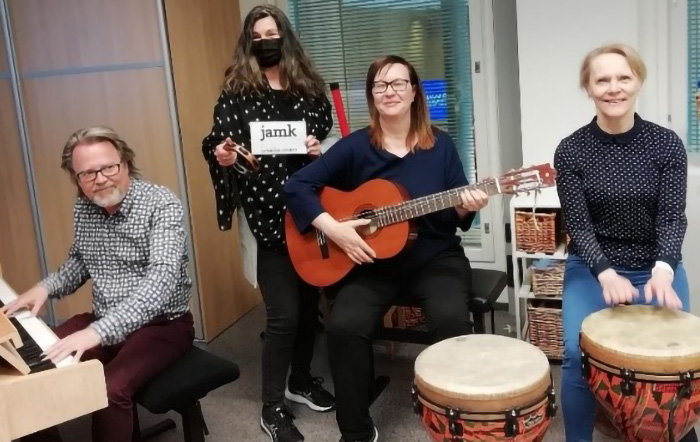SESS training meeting at JAMK’s Music Campus

Processing Complexity with Emotional, Sensorial and Spiritual capacities (ProCESS) project invents new ways of training student managers and current managers on how to address complexity, with the main lever being the development of Sensorial, Emotional and Spiritual Skills (SESS) on an equal basis with “hard skills” and “soft skills”. At JAMK there are two SESS Trainers in ProCESS project, Ari Korhonen and Marcella Zoccoli. Academic Coach, Anne Eskola, and Project Manager, Anneli Kakko, had a memorable meeting with JAMK SESS Trainers at JAMK’s Music Campus on Monday 24th of May.
At the beginning of the meeting, Ari Korhonen explained the theoretical foundations of the Music Therapy. Then he explained the Clinical Improvisation which is a systematic process of interventions to promote the well- being of the client. Music relationship and music experiences of the client are in a very important role in this music therapy method. The therapist and the client synchronize their music playing creating an auditive reflection of their consciousness and thus generate a mutual experience of existence.
Clinical improvisation act does not require any musical competence of the client. The results are evaluated by therapeutic criterions only. During the therapeutic session the client is free to play whatever and however he or she likes. The role of the therapist is to apply so called “empathy techniques” to the musical information of the client. By using different kind of Empathy Techniques, the therapist can synchronize his or her playing to the musical information of the client. According to Bruscia [1] there is 64 different kind of empathy technique variations. Most commonly used techniques are:
- Matching: Playing that corresponds to, and is harmonious with, the music
- Mirroring, synchronizing, shadowing, doubling: Producing a detailed reproduction of the music as it is being played.
- Imitating, echoing, copying: Playing the same thing as someone else, after they play it.
- Quoting: Incorporating previously played material, in whole or part.
- Exaggerating: articulate the played material of the client magnifying the main points
This technique of empathy can be represented in terms of individual way of playing, musical relationships; and how the use of the techniques impacts the participant’s experience of musical connection, influence, and expression. This process is always a dialogue where participants immerse themselves in the rich and delicate musical interaction that reflects the everyday situations between the people.
Ari Korhonen also demonstrated how music therapy works in practice with two pianos and the assistance of Marcella Zoccoli. Having seen the impressive demonstration, it was inspiring to design the SESS Training contents for JAMK and try out the method with a very quick creation of JAMK band.
Reference
[1] Bruscia, K. (1987). Improvisational models of music therapy. Springfield, IL: Charles C. Thomas
Writers:
Anneli Kakko, Project Manager, JAMK University of Applied Sciences
Ari Korhonen, Lecturer, JAMK University of Applied Sciences